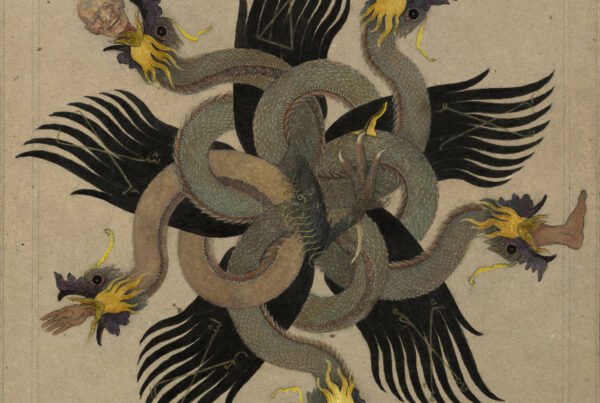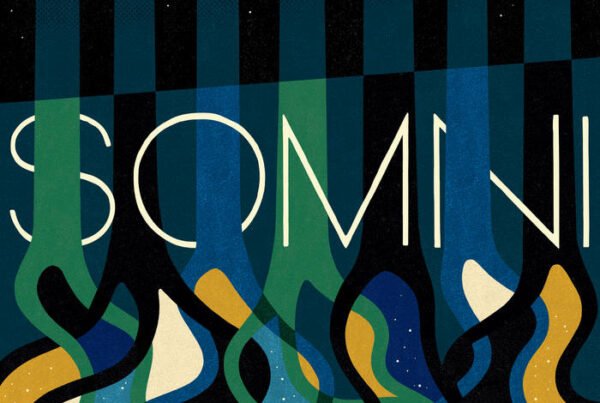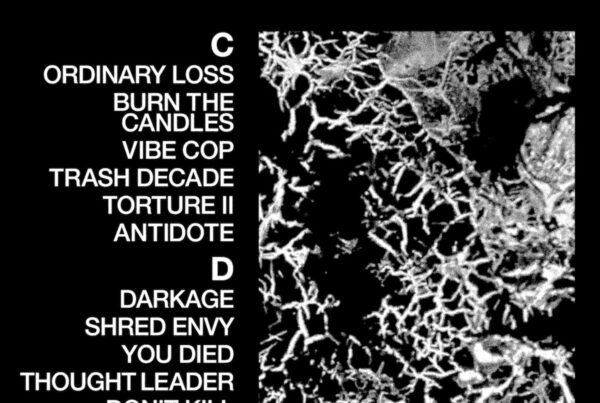The Callous Daoboys evolve like a Pokemon with I Don’t Want to See You in Heaven, an album that’s cascading with dense riffs as much as it is the pangs of emotional growth
Release date: May 16, 2025 | MNRK Heavy | Instagram | Facebook | Twitter | TikTok | Bandcamp
We talk a lot about growth of bands and artists here. I think many see it as a cop-out to focus on that when talking about a band – the members of a band get older, they mature, of course their art will with them! Obviously not always true, sometimes even on purpose, but for me there really is something to be said for the course that bands choose to take and it’s not always as simple as shifting sounds or genres. I prefer talking about it in terms of growth or evolution which I get may just come down to semantics. I think the assumption that music is ‘immature’ if it’s not doing something totally correct in someone’s eyes or a band’s youthful energy often gets in the way of whatever songwriting standards someone has is weird, and I know by referring to any music as ‘mature’ that implies the existence of immature music in my own referential headspace, but thinking about it deeper, I don’t really care to engage music like that anymore. I also don’t hate fun – in fact, I’d argue I’m one of the biggest fun likers here.
This is all relevant because I’ve heard all manner of this talk said about The Callous Daoboys, a band I really only came on board with when their last album Celebrity Therapist dropped. Why only then? Well, I hadn’t heard of them too much beforehand and when I did, their aesthetic didn’t speak to me. Given their name, logo, and song titles, I figured they were another weirdo deathcore-ish band and I don’t get on too well with those. It was dismissive and paradoxically immature of myself to do that because, looking back, the music was pretty good. So consider this review an extended take on the ‘we listen and we don’t judge’ social media trend that by now is pretty outdated.
It’s true; we’ve come a long way since the band’s first LP, wonderfully named My Dixie Wrecked, something written and produced in the band’s late teens. Now all coasting closer to their 30s I assume, The Callous Daoboys reckon with past mistakes, regrets, and shortcomings. I Don’t Want to See You in Heaven is framed as a collection of bygone art in the Museum of Failure 300 years in the future, contextualized in the intro by the voice of a cultural historian or curator, telling about how the works had to be marked as historically important to be transferred over boarders to get where it’s at, and how part of Arkansas is considered an occupied zone now, all over the sweet saxophone stylings of frequent collaborator Rich Castillo. It’s a dystopian framing for a vulnerable album, cute on one hand, but seemingly prophetic in the other. Vocalist Carson Pace gives some real-world context by saying, ‘It’s every emotion I’ve felt and sobering thought I’ve thought since 2021. I can only make this album now, not in three years when I’m thirty, not ten years ago when I was seventeen. This is the snapshot of 24-27. A scrapbook of trial and error, or better yet, a Museum of Failure.‘
It’s also a showcase of sonic balance and variety. This is by far the most diverse album the band’s ever put together, and it goes a bit beyond the ‘heavy band goes clean/pop’ aspect that gets thrown around a lot, not to mention this approach isn’t new to the band, but it is more refined. The second track/first song after our vintage expositional setup is quick to start the action with mathy metal collisions of melody, but Pace’s rock-solid clean singing sets it apart from the rest in a way that pedestals it as a sing-/scream-along hit for the ex-scene and emo kids that we all know or once were. “Schizophrenia Legacy” melds two disparate climates in one track well, but when the band settles into one particular modality, that’s when magic happens.
“Lemon” was a bold single for the band. Immediately, I saw it revered or cast off with little in-between by fans or at least those who bothered to give it a try. There’s a YouTube comment on the video calling them, affectionately, The Fallous Outboys which is just funny and something the band leaned into, with many others enjoying the ride and change of pace. Personally, it’s what made me sign up to review this album because if nothing else, it sparks curiosity, but it’s deeper than that. Given the framing of the album as Pace’s most autobiographical work yet, it touches on a lot as alluded to above. A song like “Lemon” therefore feels like a moment of grace from Pace to himself and others who relate, reflecting on what was and perhaps what will be – the inevitability of things. Not bad at all for a ’90s-infused radio rock track with heart.
One thing that helps color in the intent and meaning of “Lemon” and the other singles is the museum-like placards of information stamped on each one’s art and video. The one for “Lemon” for instance says ‘Here, we see perseverance as an admirable quality of the dead, but a shameful quality of the living‘ which directly rubs up against some of the lyrics in different ways. My favorite is the bridge which starts off with the lyrics, ‘Your mother saw me waiting tables and she asked if I was doing that band thing still/I always finish what I start, but I guess it’s been almost a decade of this.’ “Distracted by The Mona Lisa” has a descriptor saying ‘After a lifetime of mistakes, perfection lies ahead. With a healthy fear of abandonment in tow, there is no other option but proclamation‘ which is pretty good for a song that references vows and marriage at an altar, but I feel like I’m missing a deeper facet of it. Either way, the song has some of the boldest melodies on the album and I love the haunting, moaning violin from Amber Christman between verses.
The Callous Daoboys get really playful on I Don’t Want to See You in Heaven. The bisecting drum ‘n’ bass part of “Tears on Lambo Leather” is tasty, breaking up an intense song featuring straight-edge hardcore stompers, Orthodox. I love the serene calmness of “Body Horror For Birds” – if you thought “Lemon” was soft, then haaaaaa. Even the simple nonsense chanting in “Idiot Temptation Force” has lore that links back to Pace’s pastor great-grandfather as that’s how he’d answer the phone per an interview with Knotfest. And the flute at the beginning of “Douchebag Safari”? Made me laugh. It all speaks to a level of comfort that the band all seem to have now, with three of the sextet (Pace, Christman, and guitarist Maddie Caffrey who has a hell of a Twitter presence) persevering together since their first release. It feels like the lowering of guards, an introspection that couldn’t, and therefore isn’t, distilled only through serrated mathcore entropy and instead reflects the very real, very complicated nuance of contending with your past actions and present emotions about them.
So I guess The Callous Daoboys grew up, but what does that even mean anymore? I don’t think the band should concern themselves with it. They’re clearly venturing roughshod through heavy music’s seemingly impossible vastness, doing whatever the hell they want, and succeeding on just about every front that matters. I think the only metric of doing life correctly should be consistent reflection and growth in one’s self – well, we got six (6) musically talented Atlantans doing that before our eyes, creating art that’s acerbic, relatable, and fun. I Don’t Want to See You in Heaven is easily my favorite LP of the band so far, and it’s one I think a lot of fans will appreciate for its honesty, both thematically and sonically. At this rate, expect the unexpected, both in life and whatever these pals have coming up next.
Band photo by Nick Karp






